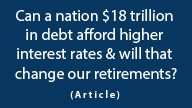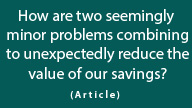The Eight Energy Systems Driving The Stock Market Rout
by Daniel R. Amerman, CFA
Below is the 2nd half of this article, and it begins where the 1st half which is carried on other websites left off. If you would prefer to read (or link) the article in single page form, the private one page version for subscribers can be found here:
7) Heightened Risks From Currency Warfare
"... there is a case that a de facto currency war already exists (Bloomberg article link). That is, nations are seeking competitive advantage for their own economies by creating large sums of money in order to make their currency cheaper than other countries, meaning their exports increase and their imports decrease. The issue is that because this competition is an inherently unstable and dangerous process, currency wars can spin out of control, and quite quickly.
...Again, the "perfect storm" analogy seems to be an apt one. Deliberately pushing stock and bond prices higher than they should be creates markets that are inherently unstable. Liquidity crunches are destabilizing and dangerous. Currency warfare is destabilizing and dangerous. But what is far worse is when those three destabilizing "weather systems" not only merge together but also feed "energy" to each other and as a result they triple (or more) in strength."
It is worth remembering that the immediate trigger for the stock market rout was the surprise move by the Chinese government to devalue the yuan against the US dollar. Now, that very quickly was presented by the media as being a global concern about whether Chinese economic growth was worse than realized.
Why was this believed? Because the primary reason a nation devalues its own currency is to gain economic advantage at the expense of other nations. The world's second largest economy, which had been more or less on the sidelines recently, just launched a currency warfare offensive against the US dollar, the euro, the yen and the other currencies of the world.
Currency warfare triggered stock market instability, which created moderate but real liquidity crunch issues. The three weather system described in May did briefly converge - and the results dominated world markets.
While the downstream results of the yuan devaluation quickly overshadowed the event itself - we may still just be getting started here. If China continues to devalue the yuan - as many believe is likely - then the energy ramps up even further, and the chances of outright currency warfare increase, as do the dangers of stock and bond market instability as well as the danger of liquidity crunches, particularly with ETFs.
8) The Chinese "Trigger"
"It's also important to understand that while many view Greece to be a European problem, these "weather systems" are global in nature. That is, if Greece does "trigger" a financial crisis – that crisis won't necessarily initially manifest in Europe, and it may not happen instantly. As one possible scenario, a Greek default pushes the euro down sharply. As a defensive currency warfare measure, other nations enter into or increase their degree of quantitative easing – such as the United States, or Japan, or Australia or Canada. This then feeds the "energy", in the form of still higher asset prices and still lower liquidity. This increased instability could then quickly set off by a further deterioration in Europe, or it could be set off by something else altogether, months or years later, in an entirely different part of the world."
As mentioned, the 8th source of energy has been retitled from "Greek" to "Chinese", even as the rout moved from the bond market in the May article to the stock market in August. But the nature of the trigger does not in any way change the amount of energy in the atmosphere. China set it off in the stock market, instead of Greece in the bond market. But the energy remains.
A Radar Map That Is "Lighting Up"
"Per the International Monetary Fund, and as explored in this article (link here), modern severe financial crises can stem from the intersection of three separate but deeply intertwined risks – those of contagion risk, liquidity risk and counterparty risk.
And this "perfect storm" that is developing is starting to look like it could potentially trigger all three of these risks.
Now, does this mean a certain end of the financial world as we know it?
No.
To keep with the weather analogy, what it means is that we seem to be at that place where "high energy systems" and fronts have been popping up all over the place, and really getting those meteorologists on the Weather Channel all worked up. They can't give us a forecast with certainty, the models are conflicting, they don't know the exact storm tracks, and they don't know all the details about what is strengthening or weakening.
But what they do know is that a previously relatively boring radar map has been replaced by surging energy and a multiplying array of new systems. They know that a rapidly evolving situation has come into existence where an event of historic magnitude is entirely possible, and it can happen with great speed."
As it turns out we have seen contagion risk - in the immediate global nature of the stock market rout - as well some aspects of liquidity risk, particularly on Monday morning. But things never really kicked fully into gear, at least not so far.
The takeaway - and what makes this so different from other corrections and bear markets - is that the atmospheric energy was not released. Indeed, the radar map is still lit up from one end to another, and the colors are brighter than they were in May.
Now usually, the opposite is true with corrections and bear markets. The pressure of fundamental overvaluation is lessened by the markets moving prices downwards. So with a normal correction in normal markets, the number of systems on the radar map should decrease, and the colors grow dimmer.
But with the current situation, we still have artificially low interest rates propping up artificially high prices - with enormous latent energy waiting to be released.
The dangers of a liquidity crunch have been confirmed, as have the new dangers of ETFs during a liquidity crunch - but neither problem has been solved. So the energy is still there.
With bond and stock market routs in the span of six months - we do have solid confirmation that "the natives are restless", and the institutional investors have lost at least some of the trust in central banks that the relatively placid markets of recent years have depended upon.
We also have likely confirmation that the globe's 2nd largest economy has rejoined the currency warfare game, which dramatically increases the chances of very bad things happening. That part of the radar just went from dark green to yellow, and may yet go to red in the near future if China continues to move the yuan downwards.
All of that said, it remains true that the financial meteorologists "...can't give us a forecast with certainty, the models are conflicting, they don't know the exact storm tracks, and they don't know all the details about what is strengthening or weakening."
But we do know that the energy that became so visible earlier in 2015 is entirely real, and the radar is more crowded than ever.
 What you have just read is an "eye-opener" about one aspect of the often hidden redistributions of wealth that go on all around us, every day.
What you have just read is an "eye-opener" about one aspect of the often hidden redistributions of wealth that go on all around us, every day.
 A personal retirement "eye-opener" linked here shows how the government's actions to reduce interest payments on the national debt can reduce retirement investment wealth accumulation by 95% over thirty years, and how the government is reducing standards of living for those already retired by almost 50%.
A personal retirement "eye-opener" linked here shows how the government's actions to reduce interest payments on the national debt can reduce retirement investment wealth accumulation by 95% over thirty years, and how the government is reducing standards of living for those already retired by almost 50%.
 An "eye-opener" tutorial of a quite different kind is linked here, and it shows how governments use inflation and the tax code to take wealth from unknowing precious metals investors, so that the higher inflation goes, and the higher precious metals prices climb - the more of the investor's net worth ends up with the government.
An "eye-opener" tutorial of a quite different kind is linked here, and it shows how governments use inflation and the tax code to take wealth from unknowing precious metals investors, so that the higher inflation goes, and the higher precious metals prices climb - the more of the investor's net worth ends up with the government.
 Another "eye-opener" tutorial is linked here, and it shows how governments can use the 1-2 combination of their control over both interest rates and inflation to take wealth from unsuspecting private savers in order to pay down massive public debts.
Another "eye-opener" tutorial is linked here, and it shows how governments can use the 1-2 combination of their control over both interest rates and inflation to take wealth from unsuspecting private savers in order to pay down massive public debts.







If you find these "eye-openers" to be interesting and useful, there is an entire free book of them available here, including many that are only in the book. The advantage to the book is that the tutorials can build on each other, so that in combination we can find ways of defending ourselves, and even learn how to position ourselves to benefit from the hidden redistributions of wealth.



















